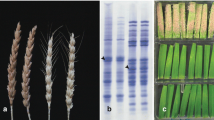Summary
Seedlings of date palm (Phoenix dactylifera L.), obtained from seven cultivars crossed with two males, were analyzed by polyacrylamide gel electrophoresis for esterase (EST), glutamate oxaloacetate transaminase (GOT), endopeptidase (ENP) and alcohol dehydrogenase (ADH) polymorphisms. Eleven, eight, five and two phenotypes were revealed for the enzymes tested, respectively. Seedlings of F1 populations derived from Bayoud (Fusarium)-resistant and low fruit quality cultivars were characterized by a high electrophoretic polymorphism, when compared with progenies of Bayoud-susceptible and high fruit quality cultivars. In almost all cases, the most frequent electrophoretic phenotypes scored for each enzyme in different F1 populations, were similar to those of the corresponding parent cultivars. Heterozygous phenotypes have been found for, at least, 3 loci; Got-2, Est-1 and Enp, indicating that such loci could be used to screen for hybrid seedlings. The expected Mendelian segregation of allozymes has been observed for these 3 loci, in many F1 populations. It seems that progenies of Bayoud-resistant cultivars are characterized by a high level of electrophoretic polymorphism. The estimation of this index and the search for genetic linkage with segregating allozymes, may be biochemical criteria useful as an aid in distinguishing date palm seedling populations derived from Bayoud-resistant cultivars and suitable for breeding programs.
Similar content being viewed by others
References
Al-Helal, A.A., 1988. Amylase isoenzymes and protein of date palm (Phoenix dactylifera L.). Bot. Bull. Academia Sinica 29: 239–244.
Al-Mouemar, A. & J.Gasquez, 1983. Environmental conditions and isozyme polymorphism in Chenopodium album L. Weed Res. 23: 141–149.
Baaziz, M. & M.Saaidi, 1988. Preliminary identification of date palm cultivars by esterase isoenzymes and peroxidase activities. Can. J. Bot. 66: 89–93.
Bennaceur, C., C.Lanaud, M.H.Chevallier & N.Bounaga, 1991. Genetic diversity of the date palm (Phoenix dactylifera L.) from Algeria revealed by enzyme markers. Plant Breed. 107: 56–69.
Byrne, D.H. & T.G.Littleton, 1989. Interspecific hybrid verification of Plum x Apricot hybrids via isozyme analyses. HortScience 24: 132–134.
Chandra-Sekhar, K.N.C. & D.A.DeMason, 1988. Quantitative ultrastructure and protein composition of date palm (Phoenix dactylifera L.) seeds: a comparative study of endosperm vs. embryo. Amer. J. Bot. 75: 323–329.
Dabo, S.M., C.M.Taliaferro & E.D.Mitchell, 1990. Bermudagrass cultivar identification by use of isoenzyme electrophoretic patterns. Euphytica 51: 25–31.
Feuerstein, E., A.H.D.Brown & J.J.Burdon, 1990. Linkage of rust resistance genes from wild barley (Hordeum spontaneum) with isozyme markers. Plant Breed. 104: 318–324.
Gasquez, J. & J.P.Compoint, 1981. Isoenzymatic variation in populations of Chenopodium album L. resistant and susceptible to triazines. Agro-Ecosystem 7: 1–10.
Guenegou, M.C., J.Citharel & J.E.Levasseur, 1988. The hybrid status of Spartina anglica (Poaceae). Enzymatic analysis of the species and the presumed parents. Can. J. Bot. 66: 1830–1833.
Kahler, A.L., R.W.Allard, A.M.Krzakow, C.G.Wehrhahn & E.Nevo, 1980. Associations between isozyme phenotypes and environment in the slender wild oat (Avena barbata). Theor. Appl. Genet. 56: 31–47.
Louvet, J. & G.Toutain, 1973. Recherche sur les fusarioses. VIII. Nouvelles observations sur la fusariose du palmier dattier et précisions concernant la lutte. Ann. Phytopathol. 5: 35–52.
Maestri, E., F.M.Restivo, G.P.Marziani Longo, A.Falavigna & F.Tassi, 1991. Isozyme gene markers in the dioecious species Asparagus officinalis L. Theor. Appl. Genet. 81: 613–618.
Messina, R., R.Testolin & M.Morgante, 1991. Isozymes for cultivar identification in kiwifruit. HortScience 26: 899–902.
Nehra, N.S., K.K.Kartha & C.Stushnoff, 1991. Isozymes as markers for identification of tissue culture and greenhouse-grown strawberry cultivars. Can. J. Plant Sci. 71: 1195–1201.
Pereau-Leroy, P., 1958. Le palmier dattier au Maroc. Ministère d'Agriculture, Service de la Recherche Agronomique, Maroc et Institut Français de Recherche Fruitière Outre-Mer, Institut des Fruits et Agrumes Coloniaux.
Ramirez, L. & G.Pisabarro, 1985. Isozyme electrophoretic patterns as a tool to characterize and classify rye (Secale cereale L.) seed samples. Euphytica 34: 793–799.
Saaidi, M., 1979. Contribution à la lutte contre le Bayoud, fusariose vasculaire du palmier dattier. Thèse de Doctorat d'Université, Université de Dijon.
Stegemann, H., A.M.R.Afify & K.R.F.Hussein, 1987. Identification of date (Phoenix dactylifera L.) cultivars by protein patterns. Phytochem. 26: 149–153.
Torres, A.M. & B.Tisserat, 1980. Leaf isozymes as genetic markers in date palms. Amer. J. Bot. 67: 161–167.
Warwick, S.I. & P.B.Marriage, 1982. Geographical variation in populations of Chenopodium album resistant and susceptible to atrazine. I. Between and within-population variation in growth and response to atrazine. Can. J. Bot. 60: 483–493.
Warwick, S.I. & L.D.Black, 1986. Electrophoretic variation in triazine-resistant and susceptible populations of Amaranthus retroflexus L. New Phytol. 104: 661–670.
Wijbrandi, W., W.VanCapelle, C.J.Hanhart, E.P.VanLoenen Martinet-Schuringa & M.Koornneef, 1990. Selection and characterization of somatic hybrids between Lycopersicon esculentum and Lycopersicon peruvianum. Plant Sci. 70: 197–208.
Woods, J.H., G.M.Black & F.W.Allendorf, 1984. Using isozyme analysis to aid in selecting genetically superior Ponderosa pine for coal-mine spoil reclamation. Northwest Sci. 58: 262–268.
Author information
Authors and Affiliations
Rights and permissions
About this article
Cite this article
Bendiab, K., Baaziz, M., Brakez, Z. et al. Correlation of isoenzyme polymorphism and Bayoud-disease resistance in date palm cultivars and progeny. Euphytica 65, 23–32 (1992). https://doi.org/10.1007/BF00022196
Received:
Accepted:
Issue Date:
DOI: https://doi.org/10.1007/BF00022196




